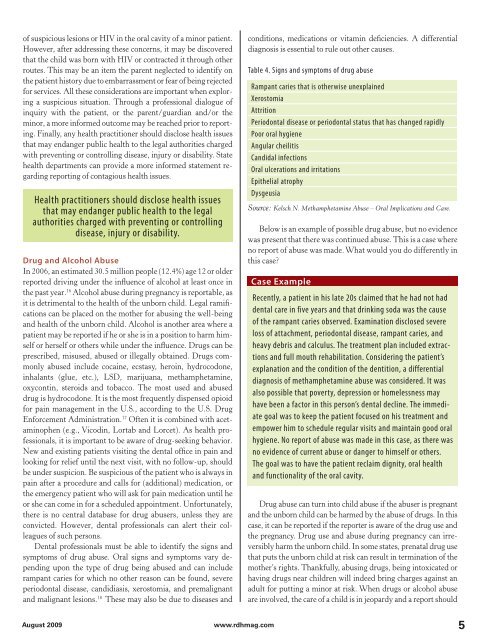Abuse: Mandated Reporting for Dental Professionals - IneedCE.com
Abuse: Mandated Reporting for Dental Professionals - IneedCE.com
Abuse: Mandated Reporting for Dental Professionals - IneedCE.com
Create successful ePaper yourself
Turn your PDF publications into a flip-book with our unique Google optimized e-Paper software.
of suspicious lesions or HIV in the oral cavity of a minor patient.<br />
However, after addressing these concerns, it may be discovered<br />
that the child was born with HIV or contracted it through other<br />
routes. This may be an item the parent neglected to identify on<br />
the patient history due to embarrassment or fear of being rejected<br />
<strong>for</strong> services. All these considerations are important when exploring<br />
a suspicious situation. Through a professional dialogue of<br />
inquiry with the patient, or the parent/guardian and/or the<br />
minor, a more in<strong>for</strong>med out<strong>com</strong>e may be reached prior to reporting.<br />
Finally, any health practitioner should disclose health issues<br />
that may endanger public health to the legal authorities charged<br />
with preventing or controlling disease, injury or disability. State<br />
health departments can provide a more in<strong>for</strong>med statement regarding<br />
reporting of contagious health issues.<br />
Health practitioners should disclose health issues<br />
that may endanger public health to the legal<br />
authorities charged with preventing or controlling<br />
disease, injury or disability.<br />
Drug and Alcohol <strong>Abuse</strong><br />
In 2006, an estimated 30.5 million people (12.4%) age 12 or older<br />
reported driving under the influence of alcohol at least once in<br />
the past year. 16 Alcohol abuse during pregnancy is reportable, as<br />
it is detrimental to the health of the unborn child. Legal ramifications<br />
can be placed on the mother <strong>for</strong> abusing the well-being<br />
and health of the unborn child. Alcohol is another area where a<br />
patient may be reported if he or she is in a position to harm himself<br />
or herself or others while under the influence. Drugs can be<br />
prescribed, misused, abused or illegally obtained. Drugs <strong>com</strong>monly<br />
abused include cocaine, ecstasy, heroin, hydrocodone,<br />
inhalants (glue, etc.), LSD, marijuana, methamphetamine,<br />
oxycontin, steroids and tobacco. The most used and abused<br />
drug is hydrocodone. It is the most frequently dispensed opioid<br />
<strong>for</strong> pain management in the U.S., according to the U.S. Drug<br />
En<strong>for</strong>cement Administration. 17 Often it is <strong>com</strong>bined with acetaminophen<br />
(e.g., Vicodin, Lortab and Lorcet). As health professionals,<br />
it is important to be aware of drug-seeking behavior.<br />
New and existing patients visiting the dental office in pain and<br />
looking <strong>for</strong> relief until the next visit, with no follow-up, should<br />
be under suspicion. Be suspicious of the patient who is always in<br />
pain after a procedure and calls <strong>for</strong> (additional) medication, or<br />
the emergency patient who will ask <strong>for</strong> pain medication until he<br />
or she can <strong>com</strong>e in <strong>for</strong> a scheduled appointment. Un<strong>for</strong>tunately,<br />
there is no central database <strong>for</strong> drug abusers, unless they are<br />
convicted. However, dental professionals can alert their colleagues<br />
of such persons.<br />
<strong>Dental</strong> professionals must be able to identify the signs and<br />
symptoms of drug abuse. Oral signs and symptoms vary depending<br />
upon the type of drug being abused and can include<br />
rampant caries <strong>for</strong> which no other reason can be found, severe<br />
periodontal disease, candidiasis, xerostomia, and premalignant<br />
and malignant lesions. 18 These may also be due to diseases and<br />
conditions, medications or vitamin deficiencies. A differential<br />
diagnosis is essential to rule out other causes.<br />
Table 4. Signs and symptoms of drug abuse<br />
Rampant caries that is otherwise unexplained<br />
Xerostomia<br />
Attrition<br />
Periodontal disease or periodontal status that has changed rapidly<br />
Poor oral hygiene<br />
Angular cheilitis<br />
Candidal infections<br />
Oral ulcerations and irritations<br />
Epithelial atrophy<br />
Dysgeusia<br />
Source: Kelsch N. Methamphetamine <strong>Abuse</strong> – Oral Implications and Care.<br />
Below is an example of possible drug abuse, but no evidence<br />
was present that there was continued abuse. This is a case where<br />
no report of abuse was made. What would you do differently in<br />
this case?<br />
Case Example<br />
Recently, a patient in his late 20s claimed that he had not had<br />
dental care in five years and that drinking soda was the cause<br />
of the rampant caries observed. Examination disclosed severe<br />
loss of attachment, periodontal disease, rampant caries, and<br />
heavy debris and calculus. The treatment plan included extractions<br />
and full mouth rehabilitation. Considering the patient’s<br />
explanation and the condition of the dentition, a differential<br />
diagnosis of methamphetamine abuse was considered. It was<br />
also possible that poverty, depression or homelessness may<br />
have been a factor in this person’s dental decline. The immediate<br />
goal was to keep the patient focused on his treatment and<br />
empower him to schedule regular visits and maintain good oral<br />
hygiene. No report of abuse was made in this case, as there was<br />
no evidence of current abuse or danger to himself or others.<br />
The goal was to have the patient reclaim dignity, oral health<br />
and functionality of the oral cavity.<br />
Drug abuse can turn into child abuse if the abuser is pregnant<br />
and the unborn child can be harmed by the abuse of drugs. In this<br />
case, it can be reported if the reporter is aware of the drug use and<br />
the pregnancy. Drug use and abuse during pregnancy can irreversibly<br />
harm the unborn child. In some states, prenatal drug use<br />
that puts the unborn child at risk can result in termination of the<br />
mother’s rights. Thankfully, abusing drugs, being intoxicated or<br />
having drugs near children will indeed bring charges against an<br />
adult <strong>for</strong> putting a minor at risk. When drugs or alcohol abuse<br />
are involved, the care of a child is in jeopardy and a report should<br />
August 2009<br />
www.rdhmag.<strong>com</strong><br />
5
















